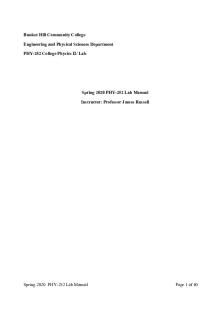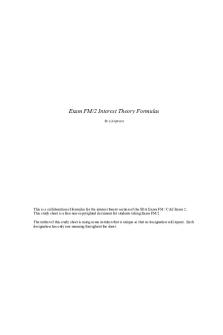Fm 2 lab manual PDF

| Title | Fm 2 lab manual |
|---|---|
| Author | IHTISHAM UL HAQ |
| Course | Fluid Mechanics |
| Institution | University of Engineering and Technology Taxila |
| Pages | 6 |
| File Size | 328.8 KB |
| File Type | |
| Total Downloads | 6 |
| Total Views | 177 |
Summary
Lab Manual of reciprocating pump...
Description
Fluids Mechanics-II Lab Manual
Experiment # 1: To Study of Reciprocating Pump Introduction: Reciprocating Pump: Reciprocating pump is a positive displacement pump where certain volume of liquid is collected in enclosed volume and is discharged using pressure difference. Reciprocating pumps are more suitable for low volumes of flow at high pressures. It is a type of reciprocating pump for less discharging and it cannot run at the higher speed. It is a type of pump that has more efficiency and it is not need for the priming. Components of Reciprocating Pump: The main components of reciprocating pump are as follows: 1. 2. 3. 4. 5. 6. 7. 8. 9.
Piston Cylinder Delivery valve Delivery pipe Suction valve Suction pipe Rotary Crank Connecting rod Air vessel
Detail About the components of Reciprocating pump: 1. Suction Pipe:
It is a type of pump in which there is a suction pipe that connects the main water reservoir and the cylinder which moving piston. The liquid is suck by this pipe from the source to the cylinder. 2. Suction Valve: Suction valve is non-return valve which means only one directional flow is possible in this type of valve. This is placed between suction pipe inlet and cylinder. 3. Delivery Pipe Delivery pipe connects cylinder of pump to the outlet source. The liquid is delivered to desired outlet location through this pipe. 1
Fluids Mechanics-II Lab Manual
4. Delivery Valve:
Delivery valve also non-return valve placed between cylinder and delivery pipe outlet. It is in closed position during suction and in opened position during discharging of liquid. 5. Cylinder: A hollow cylinder made of steel alloy or cast iron. Arrangement of piston and piston rod is inside this cylinder. Suction and release of liquid is takes place in this so, both suction and delivery pipes along with valves are connected to this cylinder. 6. Piston: It is a type of solid cylinder part that is connected with a cylinder and it moves in the cylinder by To and Fro motion. It creates the vacuum and compression in the cylinder. 7. Connecting Rod: It is a type of a rod that connects the rotary crank and the piston. That connecting rod is connected with the end of the piston that is in the cylinder of the reciprocating pump. Piston rod helps the piston to its linear motion. 8. Rotary Crank: Crank is a solid circular disc which is connected to power source like motor, engine etc. for its rotation. 9. Air Vessel: When we use the single acting pump then there is only one complete delivery in the one complete rotation so the flow will become the pulsating so we use the air vessel that is used for the continuous flow. 10. Strainer: Strainer is provided at the end of suction pipe to prevent the entrance of solids from water source into the cylinder.
Types of reciprocating Pump: The reciprocating pumps can be classified as the following types: 1. According to acting of water:
Single acting pump Double acting pump 2. According to number of cylinders:
Single cylinder pump Double cylinder pump Triple cylinder pump 3. According to Air Vessel:
With air vessel Without air vessel
2
Fluids Mechanics-II Lab Manual
Working Principle of Reciprocating Pump: Operation of reciprocating motion is done by the power source (i.e. electric motor or i.c engine). Power source gives rotary motion to crank; with the help of connecting rod we translate reciprocating motion to piston in the cylinder.
When the piston moves in the cylinder from tom dead center to bottom dead center then half rotation is completed. Then vacum will create in the inner part of the cylinder then water move from reservoir by suction pipe to the cylinder. Then it moves from bottom dead center to the top dead center and it compression occur and water move toward the delivery tube. If these processes occur in the double acting cylinder then same process occur as diagonally. The process depends upon the movement of piston in the cylinder. When the piston moves in the cylinder of double acting then at the same time compression and expansion occur. Then we use the Air vessel because
Fluids Mechanics-II Lab Manual
Negative slip of the pump: Sometimes, the actual discharge of the reciprocating pump, is more than the theoretical discharge. In such cases, the coefficient of discharge will be more than unity and the corresponding slip is known as negative slip of the pump. This is due to long suction pipe and short delivery pipe. But the water has huge mass and momentum. Then due to large moment of inertia the water and it move to the delivery tube even the piston does not come back near to the suction pipe and delivery pipe. This is actually required for the maximum discharge of water in the reciprocating pump. Expression for single acting Reciprocating pump: ALN Q= 60
Where: Q: discharge in m3/sec A: cross-section of piston or cylinder in m2 L: length of stroke in meter N: speed of crank in r.p.m
Expression for Double acting Reciprocating pump:
Q=2
ALN 60
Where: Q: discharge in m/sec A: cross-section of piston or cylinder in m2 L: length of stroke in meter N: speed of crank in r.p.m
Applications: Reciprocating pumps are positive displacement type pump are mainly used where high pressure is required more than discharge. These are used in various places like:
1. In oil Industries 4
Fluids Mechanics-II Lab Manual
2. 3. 4. 5. 6. 7. 8. 9. 10. 11. 12. 13. 14. 15. 16. 17. 18. 19.
gas Industries petrochemical and refinery industries. As a feed water pump in boiler because high pressure water is required. Hilly areas and also in agriculture. In domestic usage Conventional food Stove Handpump Car pressure washing in service station Hydraulic jack Fire fighting application Fuel injection in engines Medicine industry Some drip irrigation system Wastewater treatment Industries It is used at a place where low discharge rate is required with high pressure. It is mostly used to deliver water at large heights such as in deep well.
It is used for inflation of tyres of bicycles. It is used in places where high & continues discharge is the main priority. But the head of the pump is relatively less than that of a reciprocating pump. 20. Soap manufacturing Industries
Advantages of reciprocating pump: The advantages of reciprocating pump are described following: It has very high efficiency. It is a type of self-priming. It can deliver water at higher pressure. It can work in wide range of pressure. It gives the continuous rate of discharge. It has very high foundations. It is proven technology. It is durable type of pump. It can operate with the variety of heads pressures. It can be installed in very small diameter well. It has small internal volume. It is a positive displacement pump. The total weight of the pump is more for a given discharge. It provides high suction lift. It is also used for the air. Disadvantages of the reciprocating pump: The disadvantages of reciprocating pump are described are following:
5
Fluids Mechanics-II Lab Manual
It is very complicated in construction It has more parts in this pump. It has very high initial cost. It has very high maintenance cost. It has more wear and tear. It cannot handle dirty water. It cannot run at the higher speed. Its flow is pulsating. Thrust on the crankshaft is not uniform. Its much care is required in operation. It requires large floor area. It does not have uniform torque. Difficult to flow viscous fluid. Low discharging capacity. It has short half-life. It may damage itself.
Precautions:
First check the main electric connections. Then check the small circuits in the pump. Never start or operate a pump against the closed valve. The cradle cover must be in place while pump is running. Suction valve must be open Ensure that the drain valve is closed Use the oil bottle or atomizer for lubrication We must away from the rotating wheel. All belt and coupling guards must be firmly in place
6...
Similar Free PDFs

Fm 2 lab manual
- 6 Pages

FM
- 3 Pages

PSYC 120 Lab 2 - Lab manual
- 7 Pages

FM Questions
- 36 Pages

Fm model
- 2 Pages

CN-Lab-Manual - Full Lab Manual
- 34 Pages

Lab manual
- 49 Pages

Lab Manual
- 60 Pages

IMH-LAB- Manual manual manual
- 21 Pages

Advanced Physics 2 Lab Manual Intro
- 30 Pages
Popular Institutions
- Tinajero National High School - Annex
- Politeknik Caltex Riau
- Yokohama City University
- SGT University
- University of Al-Qadisiyah
- Divine Word College of Vigan
- Techniek College Rotterdam
- Universidade de Santiago
- Universiti Teknologi MARA Cawangan Johor Kampus Pasir Gudang
- Poltekkes Kemenkes Yogyakarta
- Baguio City National High School
- Colegio san marcos
- preparatoria uno
- Centro de Bachillerato Tecnológico Industrial y de Servicios No. 107
- Dalian Maritime University
- Quang Trung Secondary School
- Colegio Tecnológico en Informática
- Corporación Regional de Educación Superior
- Grupo CEDVA
- Dar Al Uloom University
- Centro de Estudios Preuniversitarios de la Universidad Nacional de Ingeniería
- 上智大学
- Aakash International School, Nuna Majara
- San Felipe Neri Catholic School
- Kang Chiao International School - New Taipei City
- Misamis Occidental National High School
- Institución Educativa Escuela Normal Juan Ladrilleros
- Kolehiyo ng Pantukan
- Batanes State College
- Instituto Continental
- Sekolah Menengah Kejuruan Kesehatan Kaltara (Tarakan)
- Colegio de La Inmaculada Concepcion - Cebu





